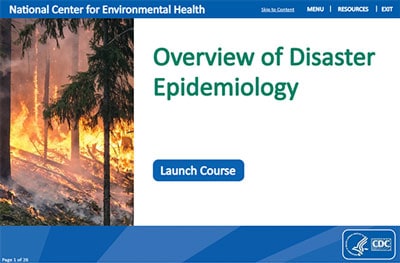Disaster Epidemiology

Disaster epidemiology assesses the short- and long-term adverse health effects of disasters to help guide emergency response and recovery efforts and predict consequences of future disasters. It provides situational awareness; that is, information that helps us understand what the needs are, plan the response, and gather the appropriate resources. The main objectives of disaster epidemiology are to
- prevent or reduce the number of deaths, illnesses, and injuries caused by disasters,
- provide timely and accurate health information for decision-makers,
- improve prevention and mitigation strategies for future disasters by collecting information for future response preparation.
NCEH provides expertise in morbidity and mortality surveillance, rapid needs assessments such as the Community Assessment for Public Health Emergency Response (CASPER), and disaster epidemiologic studies. For more information on disaster epidemiology and response, see the Frequently Asked Questions (FAQS).
During a disaster, it is important to conduct morbidity and mortality surveillance to determine the extent and scope of the health effects on the affected populations. Surveillance is the systematic collection, analysis, and interpretation of death, injury, and illness data that enables public health to identify adverse health effects in the community. It allows us to assess the human health impacts of a disaster and evaluate potential problems related to planning and prevention.
The Community Assessment for Public Health Emergency Response (CASPER) is a type of rapid needs assessment (RNA) designed to provide public health leaders and emergency managers with household-based information about a community. It is quick, reliable, relatively inexpensive, and flexible. CASPER uses valid statistical methods to gather information and can be conducted throughout the disaster cycle (preparedness, response, recovery, mitigation) and in non-disaster situations. The information generated can be used to initiate public health action; identify information gaps; facilitate disaster planning, response, and recovery activities; allocate resources; and assess new or changing needs in the community.
Public health disaster studies helps identify associations between disaster-related exposures and mortality or morbidity. It can also help evaluate specific programs or response techniques to yield decisions and assess the successfulness of the program or response. NCEH conducts epidemiologic studies and research on various disaster-related topics. Our SMEs also provide technical assistance to partners in conducting their own research.
The Disaster Epidemiology Community of Practice (DECoP)external iconexternal icon is a collaborative group of CDC; other federal; state, tribal, local, and territorial (STLT); educational; and other partners established to provide technical resources, expand the use of disaster epidemiology tools, and evaluate tools and guidelines to improve situational awareness and response activities. The DECoP hosts quarterly webinars and has developed a SharePoint site designed to be a “one-stop-shop” for all things disaster epidemiology related. For more information on DECoP, how to join, or to gain access to the SharePoint, email DECoP@cdc.gov
